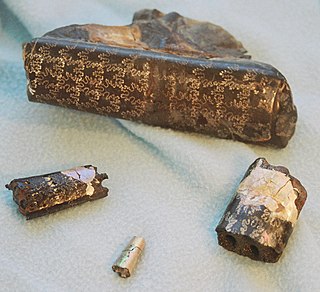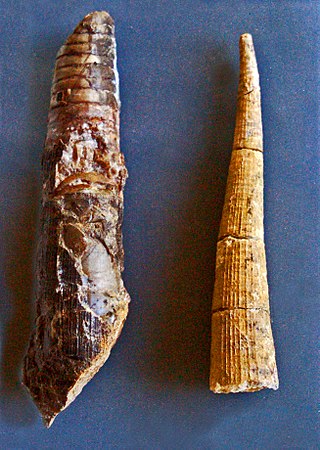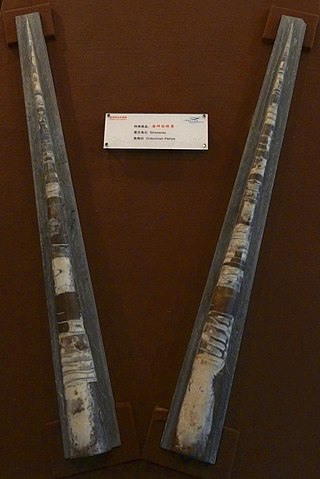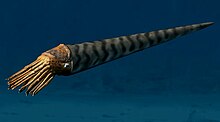
The Nautilida constitute a large and diverse order of generally coiled nautiloid cephalopods that began in the mid Paleozoic and continues to the present with a single family, the Nautilidae which includes two genera, Nautilus and Allonautilus, with six species. All told, between 22 and 34 families and 165 to 184 genera have been recognised, making this the largest order of the subclass Nautiloidea.

Nautiloids are a group of marine cephalopods (Mollusca) which originated in the Late Cambrian and are represented today by the living Nautilus and Allonautilus. Fossil nautiloids are diverse and speciose, with over 2,500 recorded species. They flourished during the early Paleozoic era, when they constituted the main predatory animals. Early in their evolution, nautiloids developed an extraordinary diversity of shell shapes, including coiled morphologies and giant straight-shelled forms (orthocones). Only a handful of rare coiled species, the nautiluses, survive to the present day.

Baculites is an extinct genus of heteromorph ammonite cephalopods with almost straight shells. The genus, which lived worldwide throughout most of the Late Cretaceous, and which briefly survived the K-Pg mass extinction event, was named by Lamarck in 1799.

Lituites is an extinct nautiloid genus from the Middle Ordovician and type for the Lituitidae that in some more recent taxonomies has been classified with the orthocerids and listed under the order Lituitida. Fossils have been found in New York, Argentina, Norway, Sweden, Estonia, and China.

Orthocerida, also known as the Michelinocerida, is an order of extinct orthoceratoid cephalopods that lived from the Early Ordovician possibly to the Late Triassic. A fossil found in the Caucasus suggests they may even have survived until the Early Cretaceous, and the Eocene fossil Antarcticeras is sometimes considered a descendant of the orthocerids although this is disputed. They were most common however from the Ordovician to the Devonian.
Cameroceras is an extinct genus of endocerid cephalopod which lived in equatorial oceans during the entire Ordovician period. Like other endocerids, it was an orthocone, meaning that its shell was fairly straight and pointed. It was particularly abundant and widespread in the Late Ordovician, inhabiting the shallow tropical seas in and around Laurentia, Baltica and Siberia.
Suecoceras is an endoceratid that lived during the Middle Ordovician. It is characterised by a long, straight, slender shell with a slightly expanded tip that curves slightly downwards.

Kionoceras is an extinct nautiloid cephalopod genus included in the orthocerid family Kionoceratidae with scattered worldwide distribution from the Middle Ordovician to the Lower Permian. Kionoceratids are orthocerids with prominent longitudinal ornamentation on their shells, sometimes augmented by secondary transverse ornamentation. Orthocerids are, of course, prehistoric nautiloides with generally straight and elongate shells, mostly with central or subcentral siphuncles.

Sinoceras is an extinct genus of nautiloids from China included in the family Orthoceratidae that lived from the middle Ordovician until the Devonian. The type species, S. chinense, was originally described as "Orthoceras chinense," but then was promoted by Shimizu and Obata to its own genus, Sinoceras, in 1935.
Baltoceratidae is an extinct family of orthoconic cephalopods belonging to the subclass Nautiloidea endemic to what would be Asia, Australia, Europe, North America, and South America during the Ordovician living from about 480–460 mya, existing for approximately 20 million years.

Dawsonoceratidae is an extinct family of orthoconic nautiloid cephalopods that lived in what would be North America and Europe from the Late Ordovician through the Middle Devonian from about 480–390 mya, existing for approximately 90 million years.
Geisonocerina is an extinct genus from the carnivorous nautiloid cephalopod order Orthocerida that lived in what would be North America, Europe, and Asia during the Ordovician through Permian from 449 to 290 mya, existing for approximately 159 million years.
Sactoceras is an extinct nautiloid cephalopod that lived during the Ordovician and Silurian in what would become North America, Europe, and Asia.

Orthoceratoidea is a major subclass of nautiloid cephalopods. Members of this subclass usually have orthoconic (straight) to slightly cyrtoconic (curved) shells, and central to subcentral siphuncles which may bear internal deposits. Orthoceratoids are also characterized by dorsomyarian muscle scars, extensive cameral deposits, and calciosiphonate connecting rings with a porous and calcitic inner layer.

The Phragmoceratidae is a family of extinct nautiloid cephalopods from the Order Discosorida that lived during the latter part of the Silurian.
Protcycloceratidae is an extinct family of slender, commonly annulate, members of the cephalopod order Ellesmerocerida that lived during the Early Ordovician.
Temperoceras is a genus of orthoconic nautiloid cephalopods that lived in what is now north Africa, Europe, and Asia during the early Paleozoic. It was named by I. V. Barskov in 1960.
Proterovaginoceras is a medium to large sized endocerid from the Early and Middle Ordovician included in the family Endoceratidae.
Murrayoceras is a nautilid cephalopod included in the orthocerid family Baltoceratidae, widespread in the Middle Ordovician of North America, characterized by a depressed orthoconic shell with a subtriangular cross section and flattened venter and a proportionally large ventral siphuncle, 0.15 to 0.3 the dorso-ventral shell diameter. Septa are close spaced with sutures forming broad lobes on the upper flanks and ventral surface.
Cyrtogomphoceras is a genus of nautiloid cephalopods, recognized by its large breviconic shell with a notable endogastric curvature. The shell is fusiform in profile, reaching maximum width at or near the base of body chamber, which narrows toward the aperture. The siphuncle is large and slightly removed from the ventral side, that with the concave longitudinal profile. Siphuncle segments are short, as are chambers; septal necks recurved, connecting rings thick, bullettes at the apical end of the rings swollen. Cameral deposits are lacking.











